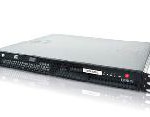Innovative Intel 45 Nanometer High-k Metal Gate Processors Go Lead-Free; Part of Intel’s Broad Commitment to Environmental Sustainability
Intel Corporation today announced that its future processors, beginning with its entire family of 45 nanometer (nm) high-k metal gate (Hi-k) processors, are going 100 percent lead-free. The Intel 45nm Hi-k family includes the next-generation Intel® Core™ 2 Duo, Core 2 Quad and Xeon® processors, and the company will begin 45nm Hi-k production in the second half of this year.
„Intel is taking an aggressive stance toward environmental sustainability, from the elimination of lead and a focus on greater energy efficiency of our products to fewer air emissions and more water and materials recycling,“ said Nasser Grayeli, Intel vice president and director of assembly test technology development, Technology and Manufacturing Group.
Lead is used in a variety of micro-electronic „packages“ and the „bumps“ that attach an Intel chip to the packages. Packages wrap around the chip and ultimately connect it to the motherboard. Different types of packages are used for processors targeted at specific market segments, including mobile, desktop and server. Package designs include pin grid array, ball grid array and land grid array, and all are 100 percent lead-free in Intel’s 45nm Hi-k technology generation. In 2008, the company will also transition its 65nm chipset products to 100 percent lead-free technology.
Intel’s 45nm processors not only are lead-free, they also make use of the company’s Hi-k silicon technology for reduced transistor leakage, enabling more energy-efficient, high-performance processors. The company’s 45nm Hi-k silicon technology also includes third-generation strained silicon for improved drive current and a lower interconnect capacitance using low-k dielectrics for increased performance and lower power. Ultimately, Intel’s 45nm Hi-k family of processors will enable sleeker, smaller and more energy-efficient desktop, notebook PC, mobile internet device and server designs.
The Road to Lead-Free
For many decades lead has been used in electronics because of its electrical and mechanical properties, making the search for replacement materials that meet performance and reliability requirements a significant scientific and technical challenge.
Due to lead’s potential impact to the environment and public health, Intel has worked for years with its suppliers and other companies in the semiconductor and electronics industry to develop lead-free solutions as part of its long-standing commitment to environmental practices. In 2002, Intel produced its first lead-free flash memory products. In 2004, the company began shipping products with 95 percent less lead than previous microprocessor and chipset packages.
To replace the remaining 5 percent (about .02 grams) of lead solder historically found in the first-level interconnect — the solder joint that connects the silicon die to the package substrate — in processor packages, Intel will use a tin/silver/copper alloy. It is the way in which Intel will implement these new materials to replace the tin/lead solder that is the „secret sauce“ of the company’s solution. Because of the complex interconnect structure of Intel’s advanced silicon technologies, a great deal of engineering work was required to remove the remaining lead in Intel’s processor packages and integrate a new solder alloy system.
Intel engineers developed the assembly manufacturing processes involving the new solder alloys, and were able to accomplish this while still demonstrating the high level of performance, quality and reliability expected of Intel components.
Environmental Sustainability — From Transistors to Factories
Intel has a long history of commitment to the environment, a philosophy that began with its founder Gordon Moore. In addition to eliminating the use of lead in its products, Intel has developed a number of environmental best-practices in its factories and operations. It is also designing and building energy efficiency into everything it does, from the smallest 45nm transistors in its forthcoming lead-free processors and today’s high-performance Intel Core 2 Duo processors that consume up to 40 percent less energy to broad support for industry standards and strong public policies. Among many examples:
- Earlier this year Intel transitioned its Intel® StrataFlash® Cellular Memory packages to halogen-free technology. The company is currently evaluating the use of halogen-free flame retardants in its CPU package technologies.
- In 1996, Intel led an industry-wide agreement to reduce global warming gas emissions in semiconductor manufacturing, and today is working with the European Union (EU) to discuss how the technology sector can help meet the EU’s target of cutting greenhouse gas emissions by 20 percent by 2020.
- Intel is focused on reducing the natural resource use and waste by products of its manufacturing process. In the past 3 years, the company has saved more than 9 billion gallons of fresh water through conservation measures, and reduced its global warming gas emissions by the equivalent of removing 50,000 automobiles from the road.
- It has reduced hazardous materials in its products and recycles more than 70 percent of its chemical and solid wastes.
- Intel makes renewable energy a priority. The company is the single-largest purchaser of wind power in Oregon and the largest industrial consumer of renewable energy in New Mexico.
- Through Intel’s ongoing conversion from 200mm to 300mm wafers, it has been able to reduce water consumption by approximately 40 percent for each square centimeter of silicon produced.
- Intel has been recognized by the U.S. Environmental Protection Agency for its work on Energy Star* and employee commuter programs.
For additional information about Intel’s commitment to the environment, visit www.intel.com/go/responsibility.
View the complete Intel® Processors Go Lead-Free press kit at http://www.intel.com/pressroom/kits/45nm/leadfree.
About Intel
Intel, the world leader in silicon innovation, develops technologies, products and initiatives to continually advance how people work and live. Additional information about Intel is available at www.intel.com/pressroom.
Intel, Intel Core, Xeon and the Intel logo are trademarks of Intel Corporation in the U.S. and other countries.
* Other brands may be claimed as the property of others.




